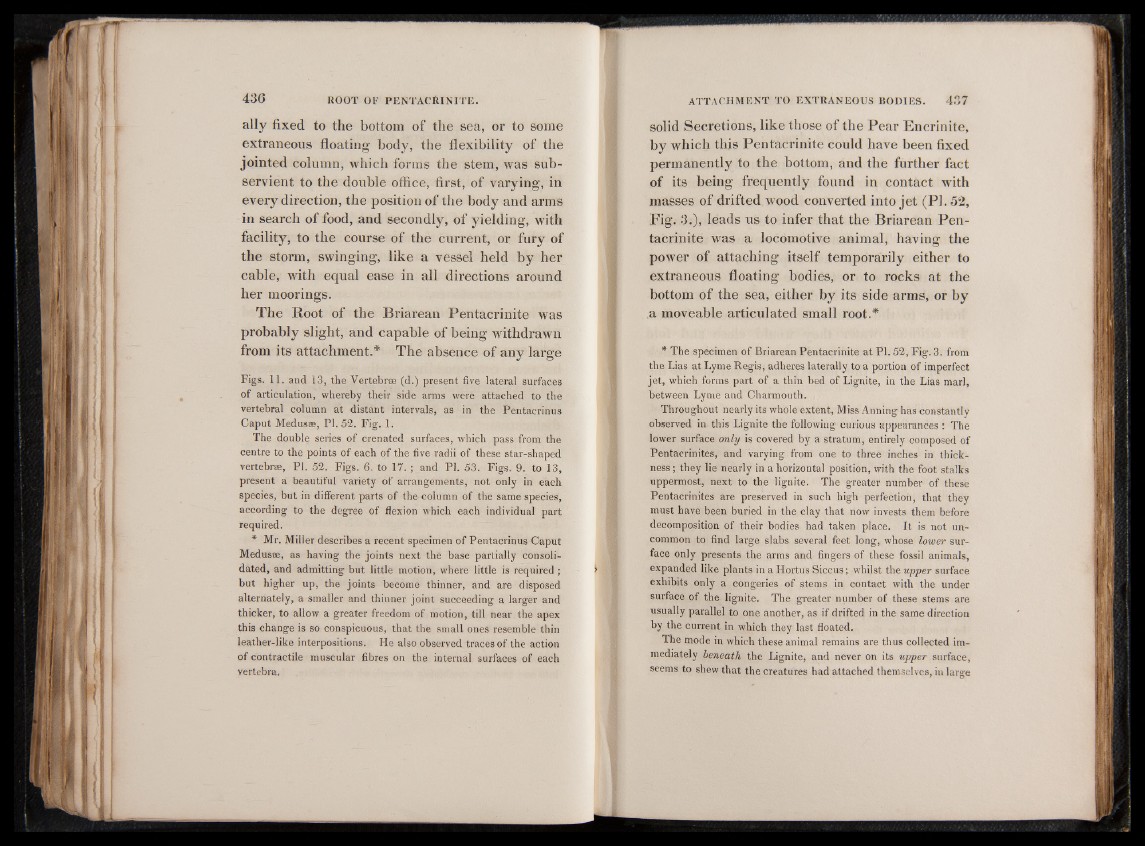
ally fixed to the bottom of the sea, or to some
extraneous floating body, the flexibility of the
jointed column, which forms the stem, was subservient
to the double office, first, of varying, in
every direction, the position of the body and arms
in search of food, and secondly, of yielding, with
facility, to the course of the current, or fury of
the storm, swinging, like a vessel held by her
cable, with equal ease in all directions around
her moorings.
The Root of the Briarean Pentacrinite was
probably slight, and capable of being withdrawn
from its attachment.* The absence of any large
Figs. 11. and 13, the Vertebrae (d.) present five lateral surfaces
of articulation, whereby tlieir side arms were attached to the
vertebral column at distant intervals, as in the Pentacrinus
Caput Medusae, PI. 52. Fig. 1.
The double series of crenated surfaces, which pass from the
centre to the points of each of the five-radii of these star-shaped
vertebrae, PI. 52. Figs. 6. to 17.; and PI. 53. Figs. 9. to 13,
present a beautiful variety of arrangements, not only in each
species, but in different parts of the column of the same species,
according to the degree of flexion which each individual part
required.
* Mr. Miller describes a recent specimen of Pentacrinus Caput
Medusae, as having the joints next the base partially consolidated,
and admitting but little motion, where little is required ;
but higher up, the joints become thinner, and are disposed
alternately, a smaller and thinner joint succeeding a larger and
thicker, to allow a greater freedom of motion, till near the apex
this change is so conspicuous, that the small ones resemble thin
leather-like interpositions. He also observed traces of the action
of contractile muscular fibres on the internal surfaces of each
vertebra.
solid Secretions, like those of the Pear Encrinite,
by which this Pentacrinite could have been fixed
permanently to the bottom, and the further fact
of its being frequently found in contact with
masses of drifted wood converted into jet (PI. 52,
Fig. 3.), leads us to infer that the Briarean Pentacrinite
was a locomotive animal, having the
power of attaching itself temporarily either to
extraneous floating bodies, or to rocks at the
bottom of the sea, either by its side arms, or by
,a moveable articulated small root.*
* The spécimen of Briarean Pentacrinite at PI. 52, Fig. 3. from
the Lias at Lyme Regis, adheres laterally to a portion of imperfect
jet, which forms part of a thin bed of Lignite, in the Lias marl,
between Lyme and Charmouth.
Throughout nearly its whole extent, Miss Anning has constantly
observed in this Lignite the following curious appearances : The
lower surface only is covered by a stratum, entirely composed of
Pentacrinites, and varying from one to three inches in thickness
; they lie nearly in a horizontal position, with the foot stalks
uppermost, next to the lignite. The greater number of these
Pentacrinites are preserved in such high perfection, that they
must have been buried in the clay that now invests them before
decomposition of their bodies had taken place. It is not uncommon
to find large slabs several feet long, whose lower surface
only presents the arms and fingers of these fossil animals,
expanded like plants in a Hortus Siccus; whilst the upper surface
exhibits only a congeries of stems in contact with the under
surface of the lignite. The greater number of these stems are
usually parallel to one another, as if drifted in the same direction
by the current in which they last floated.
The mode in which these animal remains are thus collected immediately
beneath the Lignite, and never on its upper surface,
seems to shew that the creatures had attached themselves, in large